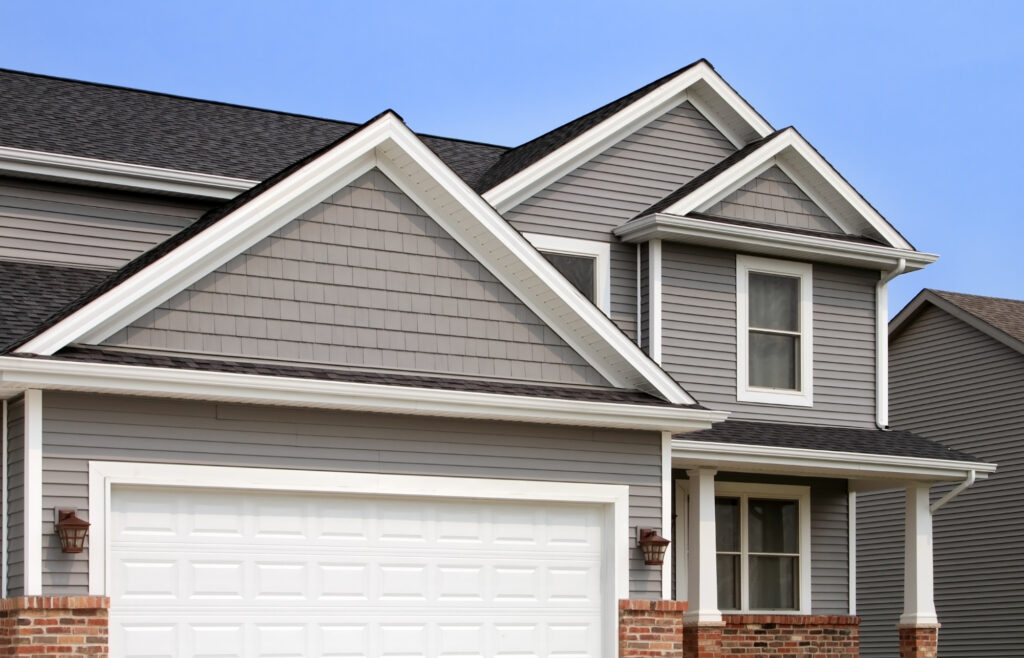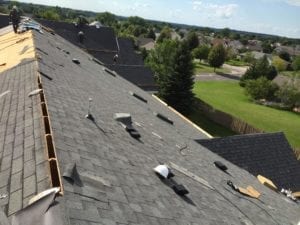To clean vinyl siding, start by removing outdoor furniture for easy access. Rinse the siding with a garden hose to eliminate loose dirt. Prepare a gentle cleaning solution using dish soap or laundry detergent mixed with water. Using a soft-bristle brush, scrub the siding from top to bottom, ensuring thorough coverage, and rinse off to prevent streaks. For stubborn stains, a solution of bleach, detergent, and water may be necessary. Regular maintenance is essential to protect your investment and prevent damage. Investigate more advanced techniques and tips for maintaining your vinyl siding effectively.
Why You Should Clean Vinyl Siding Regularly
Regular cleaning of vinyl siding is essential for preserving its appearance and preventing long-term damage.
Neglecting this maintenance can lead to the accumulation of dirt, grime, and harmful substances, which may result in costly repairs or replacements.
The Benefits of Regular Maintenance
Maintaining vinyl siding through consistent cleaning is essential for preserving its aesthetic appeal and preventing damage from dirt, grime, and mildew.
Regular maintenance helps prevent the buildup of harmful substances like algae and mildew, which can lead to permanent discoloration and structural damage. By committing to annual cleaning, homeowners can guarantee their vinyl siding remains fresh and inviting throughout the year.
Additionally, routine cleaning extends the lifespan of the siding, as well-maintained surfaces are less susceptible to degradation and costly repairs.
This proactive approach not only safeguards the siding’s integrity but also saves homeowners money in the long run by reducing the need for professional cleaning services or premature replacements.
Embracing regular maintenance is key to protecting your investment.
Risks of Neglecting Vinyl Siding Cleaning
Neglecting the cleaning of vinyl siding can result in a host of problems, including permanent discoloration and accelerated deterioration from the accumulation of dirt, algae, and mildew. Over time, this buildup not only diminishes the aesthetic appeal of the siding but also compromises its structural integrity.
In humid climates, mold and mildew can thrive, posing health risks and contributing to indoor air quality issues. Regular maintenance through cleaning is vital to avoid costly repairs or even the need for complete siding replacement.
Furthermore, environmental factors such as UV rays can exacerbate fading, making it imperative to maintain an effective cleaning routine. By prioritizing regular cleaning, homeowners can guarantee the longevity and appearance of their vinyl siding.
Tools and Materials Needed to Clean Vinyl Siding
To effectively clean vinyl siding, gather essential tools such as a soft-bristle brush with a long handle, a bucket for mixing cleaning solutions, and a garden hose for rinsing.
A soft-bristle brush will help prevent damage to the siding while ensuring a thorough clean. In addition to these tools, consider using rubber gloves for protection when handling cleaning products.
Homemade cleaning solutions, like a vinegar-water mix or dish soap diluted in water, are gentle yet effective. For tougher stains, scrub pads may be necessary, while microfiber cloths can wipe down surfaces without scratching.
If preferred, commercial vinyl siding cleaners, such as Jomax or Clorox Outdoor, can also be used for a more robust cleaning solution.
Step-by-Step Guide on How to Clean Vinyl Siding
Cleaning vinyl siding requires careful preparation and the right techniques to guarantee a thorough job without causing damage.
This guide outlines essential steps, including how to prepare the area, select appropriate cleaning solutions, and effectively rinse the siding.
Preparing the Area for Cleaning
A thorough preparation of the area surrounding the vinyl siding is essential for an effective and efficient cleaning process.
Begin by removing any outdoor furniture, planters, or decorations to guarantee unobstructed access to the siding.
Next, inspect the siding for any damage, such as cracks or loose panels, which should be addressed prior to cleaning.
Protect adjacent surfaces, including windows and plants, by covering them with plastic sheeting or tarps to guard against the cleaning solution and runoff.
Ascertain a reliable water source, such as a garden hose, is accessible for rinsing.
Choosing the Right Cleaning Solution
Selecting an appropriate cleaning solution is essential for effectively maintaining the appearance and integrity of vinyl siding.
For general vinyl siding cleaning, a mixture of dish soap or laundry detergent with water is efficient for removing dirt and grime.
To remove mold, a more potent solution can be created using 1/3 cup detergent, 2/3 cup Trisodium, 1 quart bleach, and 3 quarts water; always test in an inconspicuous area first.
Alternatively, commercial cleaners like Jomax or Clorox Outdoor can be used, mixed according to the manufacturer’s instructions.
Regular maintenance, ideally at least once a year, is vital to prevent the buildup of algae and mildew, ensuring your vinyl siding remains in excellent condition.
Cleaning Vinyl Siding Without a Pressure Washer
Maintaining the cleanliness of vinyl siding can be achieved effectively without the use of a pressure washer by following a systematic approach.
Start by rinsing the siding with a garden hose to remove loose dirt and debris.
Next, create a gentle cleaning solution by mixing dish soap or laundry detergent with water.
Using a soft bristle brush, scrub the vinyl siding from top to bottom, ensuring to address any stubborn stains with a more potent mixture if necessary.
After thoroughly cleaning, rinse the siding with clean water, again working from the top down to prevent streaks.
Regularly engaging in this cleaning vinyl siding process will help maintain its appearance and longevity, preventing the accumulation of dirt and debris.
How to Rinse Vinyl Siding Properly
Rinsing vinyl siding properly is essential to guarantee the removal of dirt and cleaning solutions while preventing streaks and damage to the surface.
Begin from the top of the siding and use a garden hose fitted with a spray nozzle that has a wide spray pattern. This guarantees even coverage and avoids concentrated water streams that might harm the siding.
Maintain a distance of 3 to 4 feet from the surface to control water pressure and prevent moisture intrusion behind the panels.
Rinse thoroughly until all cleaning solution residues are eliminated, as any leftover soap can lead to streaks and discoloration.
After rinsing, inspect the siding to confirm cleanliness, addressing any missed spots as necessary for a truly clean siding.
How to Handle Stubborn Stains on Vinyl Siding
Stubborn stains on vinyl siding, such as mold, mildew, and tough dirt, can considerably detract from its appearance.
Addressing these issues requires specific cleaning techniques and solutions tailored to effectively tackle these challenges without damaging the surface.
Removing Mold and Mildew
To effectively tackle mold and mildew on vinyl siding, it is essential to employ the right cleaning solution and techniques for best results.
A recommended cleaning solution consists of 1/3 cup of detergent, 2/3 cup of Trisodium phosphate, 1 quart of bleach, and 3 quarts of water. Apply this mixture using a soft brush, ensuring that you cover all affected areas thoroughly.
For smaller mold spots, household cleaners like Fantastik® or Windex® may suffice. Regular cleaning prevents the buildup of mold and mildew, particularly in humid environments.
After application, always rinse the cleaning solution thoroughly to eliminate any residue, which can contribute to future staining or mildew growth. Maintaining a clean surface is vital for preserving the integrity of your vinyl siding.
Dealing with Tough Dirt or Grime
Tackling tough dirt and grime on vinyl siding requires a strategic approach to guarantee effective removal without damaging the surface.
For stubborn stains, such as those caused by algae or mildew, a powerful cleaning solution may be necessary. A recommended formula includes 1/3 cup of detergent, 2/3 cup of Trisodium, 1 quart of bleach, and 3 quarts of water. Apply this solution with a non-abrasive scrub pad to clean most effectively.
Always test the cleaning solution on an inconspicuous area first to prevent discoloration.
Furthermore, regular maintenance and cleaning can greatly reduce the occurrence of tough stains, allowing for easier upkeep of your vinyl siding and preserving its appearance over time.
Tips to Maintain Vinyl Siding’s Appearance
Regular maintenance is crucial for preserving the appearance of vinyl siding and preventing the accumulation of dirt, grime, and potential stains.
To maintain your vinyl siding, clean it at least once a year using a gentle cleaning solution made from dish soap and water or a vinegar-water mixture.
Employ a soft-bristled brush or microfiber cloth to avoid damaging the surface while effectively removing dirt.
Be sure to inspect your siding regularly for stains or mold, treating any small issues promptly with diluted bleach or mildew-specific products.
Furthermore, protect adjacent surfaces during cleaning by rinsing thoroughly to prevent runoff that can lead to staining.
Following these tips will guarantee your vinyl siding remains visually appealing and durable.
Frequently Asked Questions
What’s the Best Thing to Use to Clean Vinyl Siding?
The best cleaning solution for vinyl siding includes a mixture of water and mild soap, or a 70% water to 30% white vinegar ratio. Soft brushes or cloths should be utilized to prevent surface damage during cleaning.
Is Dawn Dish Soap Good for Vinyl Siding?
Dawn dish soap is indeed effective for cleaning vinyl siding due to its gentle yet powerful grease-cutting properties. Its formulation allows for safe, regular use, preventing damage while effectively removing dirt and grime buildup.
What Should Not Be Used on Vinyl Siding?
Vinyl siding should not be cleaned with abrasive cleaners, undiluted bleach, harsh solvents, high-pressure washers, or solutions containing acids or ammonia, as these can lead to discoloration, damage, and compromised integrity of the material.
Should I Pressure Wash Vinyl Siding?
Pressure washing vinyl siding can be effective but must be approached with caution. Utilize low pressure and maintain an appropriate distance to avoid damage. Regular cleaning methods are often safer and more effective for long-term maintenance.







